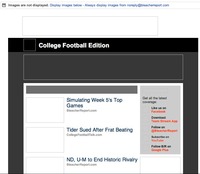12 Laws of Email Newsletters
What goes through your donor’s head when one of your emails hits the ol’ inbox?
I subscribe to a lot of email newsletters, some because I want their content and some because it’s important to see what organizations are doing. I get several each day, and from my personal experience not all of them are the same.
I look forward to some of these emails and can’t wait to open them. I scan the subject lines for something of interest. I have favorite parts I scroll to right away to read. And there are the rare few for whom I’ve gone ahead and turned images on by default!
And then there are the rest. The ones where I can tell you before I open them exactly what they’ll say. How they’ll read. And I’m not excited about them.
Recently, I’ve spent a lot of time looking at email newsletters to see what keeps my interest and what doesn’t. Here are my 12 laws of email newsletters:
1. Spam is ILLEGAL – learn about the laws you have to follow
The CAN-SPAM Act has been federal law since 2003. Fortunately, complying with this law goes hand in hand with producing better emails, getting more opens, and making your subscribers happier. Learn more about permission-based emails.
2. For newsletters, consistency and brevity are key
My rule of thumb is no more than twice a week and no less than once a month. But that also depends on the content. Still, being consistent with your email means setting and meeting recipients’ expectations. Also, consistent emails are less likely to be detected as spam.
3. Tell stories about your audience or your mission (NOT about YOU)
Newsletters are great for conveying news, but most of our news isn’t that relevant to our audience. Instead, consider your email as an opportunity to tell a phenomenal story. This is the most common problem with most nonprofit email newsletters I’ve seen. Storytelling is critical and it matters what your story is about. Is it a story people will re-tell?
4. Separate engagement and solicitation
Some people believe you should never pass on an opportunity to ask for the donation. I believe that email newsletters are engagement tools and can be great touch points. Don’t set the expectation that every communication is just a solicitation for money.
5. Newsletters are for engagement – Build anticipation for the email as its own great product
If newsletters are effective, your recipients will look forward to getting them. They’ll be sure to open them. They’ll read more. And they’ll take action. Don’t half-ass it. If you don’t have original content to draw people in, one of the best ways to add content is to point to outside sources such as recent industry articles.
6. Always have a call to action
If you’re not asking for the donation, what can you ask for? Can they like your Facebook page? Share the content or forward to a friend? Request info about your organization or a program? Volunteer to help with your next event? Find ways for people to do more than just click and read the email.
7. Call to action should be at both the top and the bottom
If someone quickly sees your email, will they see the call to action? If they read it all, will they have to scroll back to the top to get the call to action again? Why not put it in both places?
8. Design for the preview pane
Many people read their email in a preview pane or scroll past your email. Make sure your branding, key message, and call to action are visible in top 250px in case they don’t open your email in a separate window.
9. Use images to draw the eye, but make sure the email reads fine with no images displayed.
By default, many email clients (e.g., Gmail) have images turned off. The user won’t always turn images on, so you have to ensure your email will be completely functional in case you don’t get to show off the great images you used.
10. Make your subject line specific and headline-worthy
The industry average for email open rates is only about 20%. That means 80% of recipients aren’t opening the emails we send. Your subject line needs to give them a reason to open the email.

11. Write for skimming
You’ve probably seen this advice for web copywriting: use a lot of [well-crafted] headlines, bullet points, and pull quotes. It’s the same for email, and even more true. The tolerance for reading long emails is much lower than reading long websites.
12. Use the 5 second test
The 5 second test asks you to look at a mockup for 5 seconds and answer the question: what are the 3 things that stuck out the most for you? With email, you might only get 5 seconds of scanning before your recipient moves along. Use this test to figure out what the takeaways are.



Want to comment? Send me a note on Twitter or email me.